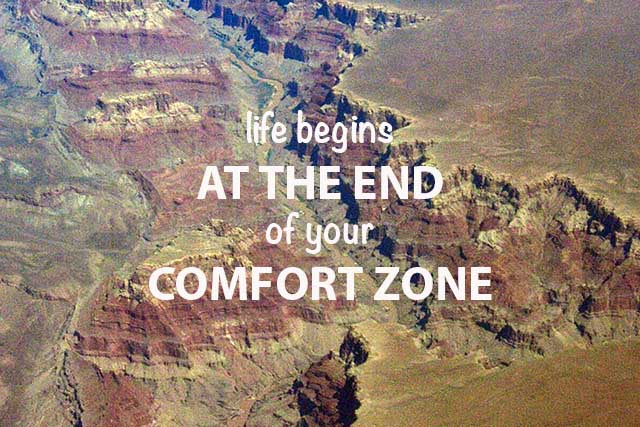
Jumbo shrimp, act naturally, accurate estimate, a little big, almost pregnant, astronomically small: the list of everyday oxymorons goes on and on. The oxymoron I want to focus on is this one: change or transition is constant.
Whether we like it or not, the one thing we can count on as a constant in our lives is change and transition. But our brains are hard-wired to resist change, even when it is positive. Fear of the unknown, trying something new, stepping out of our comfort zones, and even the anticipation of future happenings can create anxiety in individuals.
While some of us could never imagine sitting behind a desk all day or giving up a steady job, others can’t function that way. Some of us prefer to seek out new experiences, to take risks, and to frequently step out of our comfort zones. What is needed to accomplish this is the ability to focus…but that’s another article! So let’s first take the time to examine change and transition in and of themselves as well as our reactions to both.
Change can be difficult. Often, we resist change even when it will enhance our lives or make them easier. We create justifications for our resistance. Over time, these justifications become accepted reasons for not changing.
When it comes to terminology, many of confuse the words “change” and “transition,” freely exchanging one term with the other. However, they are not the same. Change is not an event, but rather a process. And that process is called transition. Transition is the inner movement or journey we make in reaction to a change. For that reason, there is actually a clear distinction between change and transition.
The essential difference between change and transition can be boiled down to this: Change is situational while transition is psychological. It’s not the events outside us that make the transition. It’s the internal process we go through to incorporate those changes.
Transitions are times when we mentally cross from something old and familiar to something new and unfamiliar. Most transitions are small and pass by almost unnoticed, while others can involve major disruptions in routines, forcing us to look at our values and lifestyles.
Many of us are instinctively afraid of change and resist it. We prefer routine and stability and remaining within our individual comfort zones. But eventually, that puts us at odds with what life really is: a series of frequent changes.
Some changes or variations are welcomed, of course, while others range from inconvenient to catastrophic whether in reality, in our minds, or both. How well we handle or cope with change and the resulting transition process can depend on the attitudes we have toward life and what our resilience level happens to be.
Having a productive, positive attitude along with the capacity to be resilient will help ease any transition. An ability to make transitions successfully frees up precious energy enabling us to live more fully in the here and now.
Transitions range from changes that affect everyone, like natural disasters, to more personal transitions that affect one’s career and relationships. Transitions can be predictable or unpredictable. They can be voluntary, like moving to a larger home, or involuntary, like an accident or an illness. Transitions and their disruptions challenge us to grow, while they can also help us focus on today and the present moment.
One way people sometimes deal with the discomfort of change is by avoiding it. Avoiding uncomfortable feelings surrounding change, however, eventually establishes patterns that stand in the way of making new beginnings.
The solution ultimately requires that we stop striving to avoid change and the inevitable transition that must follow. When we refuse to accept a transition, when the fear of what lies ahead prevents us from moving forward, we can get stuck and overwhelmed as life passes us by. Again, our response to situations is directly influenced by our attitude and how well we have developed our personal level of resilience.
Along with any kind of transition, the change that affects it can often have a negative impact our self-confidence. Think about it, when you’re not feeling confident, trying something new or out of your comfort zone or even something you may fear can be even harder. Negative self-talk can stifle professional development and advancement, making it a real challenge to sustain healthy professional and personal relationships.
Here are some tips about transition:
- To handle present and future transitions: Use the insights gained from the past along with newly acquired skills to navigate your path ahead. It’s helpful to recall the strengths that we’ve developed that have helped make transitions easier in the past.
- How to cope with and challenge our thoughts:
- Create a rite of passage: Our culture frequently lacks formal rites of passage that recognize passage from one situation to another. To remedy such a situation, a solution to this could, for example, be to hold a ceremony to acknowledge someone for a job well done. Another idea: After you’ve made a commitment, cross over a piece of tape to honor that commitment, symbolizing that you’ll follow through with it. Look at different perspectives: Weigh out the costs and benefits of each perspective.
We have the opportunity to change the way we think about something whenever we learn anything new about any topic that in turn will change our thinking. Ask yourself, how invested am I in holding on to old opinions, despite having obtained the latest information that may contradict those opinions?
- Have realistic expectations: Transition can be difficult. Be compassionate with yourself instead of being hard on yourself. Often times, negative self-talk makes us our own worst enemy. Accepting change to the fullest extent means allowing mistakes to be made along the way as you transition to the change. If you do not allow yourself to make mistakes on the journey, you will not be able to adapt well with life transitions, and will not be able to enjoy living life to its fullest.
- Transitions in the workplace: These can often be personally and professionally fulfilling. Yet they can also be difficult to manage. Switching roles and increasing responsibilities at work entails not only making adjustments to new tasks, but can also lead to a new relationship with ourselves and with those around us. The transition process can actually feel like the world has gone on “Tilt!”
- Take control of your life: Be open and flexible.
In conclusion, practice finding the good in each of life’s transitions. It’s not what happens to you that causes you to respond the way you do, but how you choose to react to what happens. Take charge of your thoughts and actions and you will be better able to control how you respond, and enhance the quality of your life.

